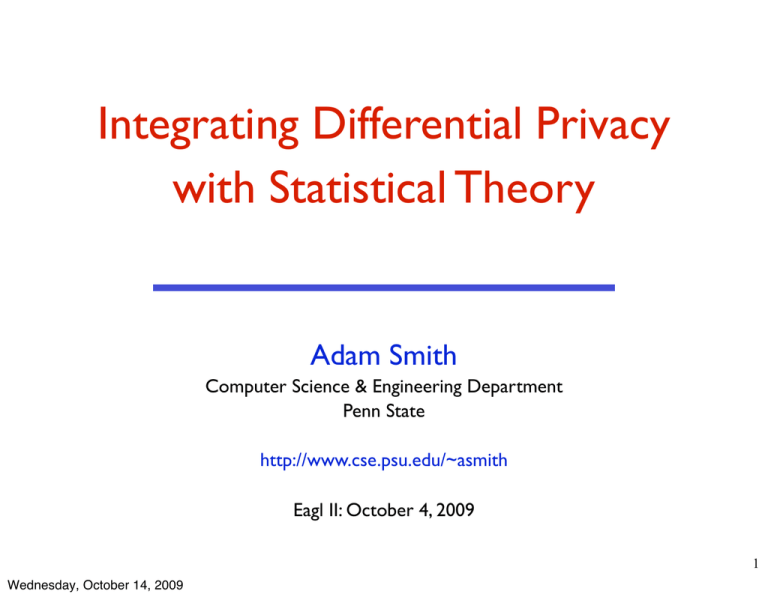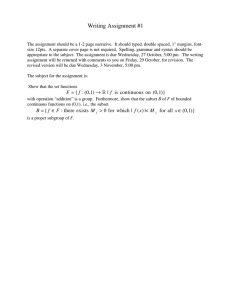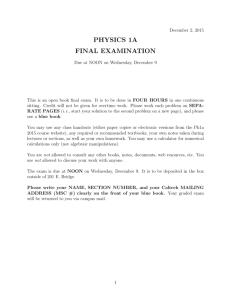Integrating Differential Privacy with Statistical Theory Adam Smith Computer Science & Engineering Department
advertisement

Integrating Differential Privacy
with Statistical Theory
Adam Smith
Computer Science & Engineering Department
Penn State
http://www.cse.psu.edu/~asmith
Eagl II: October 4, 2009
1
Wednesday, October 14, 2009
Privacy in Statistical Databases
Individuals
x1
x2
..
.
xn
Server/agency
A
local random
coins
(
queries
answers
Users
)
Government,
researchers,
businesses
(or)
Malicious
adversary
Large collections of personal information
• census data
• medical/public health data
Recently:
• social networks
• larger data sets
• recommendation systems
• more types of data
• trace data: search records, etc
• intrusion-detection systems
2
Wednesday, October 14, 2009
Privacy in Statistical Databases
3
Wednesday, October 14, 2009
Privacy in Statistical Databases
• Two conflicting goals
Utility: Users can extract “global” statistics
Confidentiality: Individual information stays hidden
• How can we define these precisely?
Variations on model studied in
• Statistics (“statistical disclosure control”)
• Data mining / database (“privacy-preserving data mining” *)
Recent: theoretical CS
3
Wednesday, October 14, 2009
Differential Privacy
Individuals
x1
x2
..
.
xn
Server/agency
A
local random
coins
(
queries
answers
Users
)
Government,
researchers,
businesses
(or)
Malicious
adversary
• Definition of privacy in statistical databases
Imposes restrictions on algorithm A generating output
• If A satisfies restrictions, then output provides privacy
no matter what user/intruder knows ahead of time
• Question: how useful are algorithms that satisfy differential
privacy?
4
Wednesday, October 14, 2009
Statistics in a Nutshell
probability
model
data
inference / learning
• This talk:
Differentially private alg’s for recovering model
Performance = convergence to “true” model
• Goals:
interesting problems + bridge linguistic gap
5
Wednesday, October 14, 2009
This talk: Valid Statistical Inference
• Construct differentially private algorithms with
same asymptotic error as best non-private algorithm
Parametric: for any* parametric model, there exists a
private, efficient estimator (i.e. minimal variance)
Nonparametric: for any* distribution on [0,1], there is a
private histogram estimator with same convergence rate as
best (non-private) histogram estimator
6
Wednesday, October 14, 2009
This talk: Valid Statistical Inference
• Construct differentially private algorithms with
same asymptotic error as best non-private algorithm
Parametric: for any* parametric model, there exists a
private, efficient estimator (i.e. minimal variance)
Nonparametric: for any* distribution on [0,1], there is a
private histogram estimator with same convergence rate as
best (non-private) histogram estimator
Other recent work along these lines:
•
•
•
•
•
Dwork, Lei 2009
Wasserman, Zhou 2008
Chaudhuri, Monteleoni 2008
McSherry, Williams 2009
...
6
Wednesday, October 14, 2009
Main Idea for both cases
• Add noise to carefully modified estimator
Several ways to design differentially private algorithms
Adding noise is the simplest
• Prove that required noise is less than inherent variability
due to sampling
original
(non-private)
estimate
Wednesday, October 14, 2009
perturbed
(private)
estimate
sampling noise
(confidence interval
)
7
Reminder: differential privacy
• Intuition:
Changes to my data not noticeable by users
Output is “independent” of my data
8
Wednesday, October 14, 2009
Defining Privacy [DiNi,DwNi,BDMN,DMNS]
x1
x2
..
.
xn
A
A(x)
local random
coins
n
=
(x
,
...,
x
)
∈
D
• Data set x
1
n
Domain D can be numbers, categories, tax forms
Think of x as fixed (not random)
• A = randomized procedure run by the agency
A(x) is a random variable distributed over possible outputs
Randomness might come from adding noise, resampling, etc.
9
Wednesday, October 14, 2009
Defining Privacy [DiNi,DwNi,BDMN,DMNS]
x1
x2
..
.
xn
x1
A
local random
coins
A(x)
x!2
..
.
xn
A
A(x’)
local random
coins
x’ is a neighbor of x
if they differ in one data point
10
Wednesday, October 14, 2009
Defining Privacy [DiNi,DwNi,BDMN,DMNS]
x1
x2
..
.
xn
x1
A
local random
coins
A(x)
x!2
..
.
xn
A
A(x’)
local random
coins
x’ is a neighbor of x
if they differ in one data point
Neighboring databases
induce close distributions
on outputs
10
Wednesday, October 14, 2009
Defining Privacy [DiNi,DwNi,BDMN,DMNS]
x1
x2
..
.
xn
x1
A
A(x)
local random
coins
x!2
A
..
.
xn
A(x’)
local random
coins
x’ is a neighbor of x
if they differ in one data point
Definition: A is ε-differentially private if,
for all neighbors x, x’,
for all subsets S of outputs
!
Neighboring databases
induce close distributions
on outputs
Pr(A(x) ∈ S) ≤ e · Pr(A(x ) ∈ S)
!
10
Wednesday, October 14, 2009
Defining Privacy [DiNi,DwNi,BDMN,DMNS]
• This is a condition on the algorithm (process) A
Saying “this output is safe” doesn’t take into account how it
was computed
• Semantics:
no matter what user knows ahead of time,
learn the same things about me
whether or not my data is present
Definition: A is ε-differentially private if,
for all neighbors x, x’,
for all subsets S of outputs
!
Neighboring databases
induce close distributions
on outputs
Pr(A(x) ∈ S) ≤ e · Pr(A(x ) ∈ S)
!
11
Wednesday, October 14, 2009
Example: Perturbing the Average
x1
x2
..
.
xn
A
A(x) = x̄ + noise
local random
coins
xi ∈ {0, 1}
x̄ =
1
n
!
i
xi
12
Wednesday, October 14, 2009
Example: Perturbing the Average
x1
x2
..
.
xn
A
A(x) = x̄ + noise
local random
coins
• Data points are binary responses
xi ∈ {0, 1}
• Server wants to release average x̄ =
1
n
!
i
xi
12
Wednesday, October 14, 2009
Example: Perturbing the Average
x1
x2
..
.
xn
A
local random
coins
A(x) = x̄ + noise
≈ x̄ ±
• Data points are binary responses
1
!n
xi ∈ {0, 1}
• Server wants to release average x̄ =
1
n
!
i
xi
• Claim: Can obtain ε-differential privacy with noise ≈
1
!n
12
Wednesday, October 14, 2009
Example: Perturbing the Average
x1
x2
..
.
xn
A
local random
coins
A(x) = x̄ + noise
≈ x̄ ±
• Data points are binary responses
1
!n
xi ∈ {0, 1}
• Server wants to release average x̄ =
1
n
!
i
xi
• Claim: Can obtain ε-differential privacy with noise ≈
1
!n
• Is this a lot?
If x is a random sample from a large underlying population,
1
then sampling noise ≈ √
n
Statistical error swamps noise required for privacy
12
Wednesday, October 14, 2009
Example: Perturbing the Average
x1
x2
..
.
xn
A
A(x) = x̄ + noise
local random
coins
xi ∈ {0, 1}
x̄ =
1
n
!
i
xi
13
Wednesday, October 14, 2009
Example: Perturbing the Average
x1
x2
..
.
xn
A
local random
coins
A(x) = x̄ + noise
≈ x̄ ±
• Data points are binary responses
1
!n
xi ∈ {0, 1}
• Server wants to release average x̄ =
1
n
!
i
xi
• Claim: Can obtain ε-differential privacy with noise ≈
1
!n
13
Wednesday, October 14, 2009
Example: Perturbing the Average
x1
x2
..
.
xn
A(x) = x̄ + noise
A
local random
coins
≈ x̄ ±
• Data points are binary responses
1
!n
xi ∈ {0, 1}
• Server wants to release average x̄ =
1
n
!
i
xi
• Claim: Can obtain ε-differential privacy with noise ≈
1
!n
Laplace distribution Lap(λ) has density h(y) ∝ e−|y|/λ
Sliding property:
h(y)
h(y+δ)
≤ eδ/λ
h(y)
y
13
Wednesday, October 14, 2009
Example: Perturbing the Average
x1
x2
..
.
xn
A(x) = x̄ + noise
A
local random
coins
≈ x̄ ±
• Data points are binary responses
1
!n
xi ∈ {0, 1}
• Server wants to release average x̄ =
1
n
!
i
xi
• Claim: Can obtain ε-differential privacy with noise ≈
1
!n
Laplace distribution Lap(λ) has density h(y) ∝ e−|y|/λ
Sliding property:
h(y)
h(y+δ)
≤ eδ/λ
h(y + δ)
h(y)
y
13
Wednesday, October 14, 2009
Example: Perturbing the Average
x1
x2
A(x) = x̄ + noise
A
..
.
xn
≈ x̄ ±
local random
coins
• Data points are binary responses
1
!n
xi ∈ {0, 1}
• Server wants to release average x̄ =
1
n
!
i
xi
• Claim: Can obtain ε-differential privacy with noise ≈
1
!n
Laplace distribution Lap(λ) has density h(y) ∝ e−|y|/λ
Sliding property:
h(y)
h(y+δ)
≤ eδ/λ
h(y + δ)
h(y)
A(x) = blue curve, A(x’) = red curve
δ = |x̄ − x̄! | ≤
Wednesday, October 14, 2009
1
n
=⇒
blue curve
≤ e!
red curve
y
13
When Does Noise Not Matter?
1
• Average: A(x) = x̄ + Lap( !n
)
Suppose X1, X2, X3, ...,Xn are i.i.d. random variables
√
D
X̄ is a random variable, and n · (X̄ − µ)−→Normal
A(X) − X̄ P
−→0
StdDev(X̄)
if ! !
√1
n
No “cost” to privacy:
• A(X) is “as good as” X̄ for statistical inference*
X̄
-1.5
-1
-0.5
A(X)
0.8
0
0.5
1
1.5
14
Wednesday, October 14, 2009
When Does Noise Not Matter?
15
Wednesday, October 14, 2009
When Does Noise Not Matter?
• Mean example generalizes to other statistics
• Theorem: For any* exponential family, can release
“approximately sufficient” statistics
Suff. stats T(X) are sums, add noise d for dimension d
!n
P
A(X) − T (X) −→0
StdDev(T (X))
15
Wednesday, October 14, 2009
When Does Noise Not Matter?
• Mean example generalizes to other statistics
• Theorem: For any* exponential family, can release
“approximately sufficient” statistics
Suff. stats T(X) are sums, add noise d for dimension d
!n
P
A(X) − T (X) −→0
StdDev(T (X))
• Asymptotic result: Indicates that useful analysis possible
Requires more sophisticated processing for small n
15
Wednesday, October 14, 2009
When Does Noise Not Matter?
• Mean example generalizes to other statistics
• Theorem: For any* exponential family, can release
“approximately sufficient” statistics
Suff. stats T(X) are sums, add noise d for dimension d
!n
P
A(X) − T (X) −→0
StdDev(T (X))
• Asymptotic result: Indicates that useful analysis possible
Requires more sophisticated processing for small n
• Noise degrades with dimension
More information ⇒ less privacy
Research question: Is this necessary?
15
Wednesday, October 14, 2009
• Histogram Density Estimation
Calibrating noise to sensitivity
• Maximum Likelihood Estimator
Sub-sample and aggregate
16
Wednesday, October 14, 2009
Global Sensitivity [DMNS06]
Individuals
x1
x2
Server/agency
..
.
xn
A
f(x) + noise
User
local random
coins
• Intuition: f(x) can be released accurately when f is insensitive
to individual entries x1 , x2 , . . . , xn
• Global Sensitivity:
GSf =
• Example: GSaverage =
max
!
!f
(x)
−
f
(x
)!1
!
neighbors x,x
1
n
17
Wednesday, October 14, 2009
Global Sensitivity [DMNS06]
Individuals
x1
x2
Server/agency
A
..
.
xn
f(x) + noise
User
local random
coins
• Intuition: f(x) can be released accurately when f is insensitive
to individual entries x1 , x2 , . . . , xn
• Global Sensitivity:
GSf =
• Example: GSaverage =
!
!f
(x)
−
f
(x
)!1
!
neighbors x,x
1
n
Theorem: If A(x) = f (x) + Lap
Wednesday, October 14, 2009
max
!
GSf
!
"
, then A is !-differentially private.
17
Example: Histograms
f (x) = (n1 , n2 , ..., , nd ) where nj = #{i : xi in j-th interval}
Lap(1/!)
0
1/d
1
18
Wednesday, October 14, 2009
Example: Histograms
• Say x1,x2,...,xn in [0,1]
Partition [0,1] into d intervals of equal size
f (x) = (n1 , n2 , ..., , nd ) where nj = #{i : xi in j-th interval}
GSf = 2
Sufficient to add noise Lap(1/!) to each count
• Independent of the dimension
0
1/d
1
18
Wednesday, October 14, 2009
Example: Histograms
• Say x1,x2,...,xn in [0,1] arbitrary domain D
Partition [0,1] into d intervals of equal size into d disjoint “bins”
f (x) = (n1 , n2 , ..., , nd ) where nj = #{i : xi in j-th interval}bin
GSf = 2
Sufficient to add noise Lap(1/!) to each count
• Independent of the dimension
0
1/d
1
18
Wednesday, October 14, 2009
Example: Histograms
• Say x1,x2,...,xn in [0,1]
Partition [0,1] into d intervals of equal size
f (x) = (n1 , n2 , ..., , nd ) where nj = #{i : xi in j-th interval}
GSf = 2
Sufficient to add noise Lap(1/!) to each count
• Independent of the dimension
• For any smooth density h, if Xi i.i.d. ~ h,
noisy histogram converges to h
Expected L2 error O(
1
√
3 n)
1
if n ! 3
!
Same as “best” non-private estimator
0
1/d
1
19
Wednesday, October 14, 2009
Proof
• L2 error:
!
" # 1
IM SE = Eĥ !h − ĥ!22 =
(h − ĥ)2 dx
0
• If bins have fixed width t
1
1
2
!
Theorem [Scott]: IM SE =
+ t R(h ) +
nt
n
√
3
Minimized for t = n
• Additional square error due to noise
Additional error per bin t ×
1
t2 n2 !2
Total additional error:
ĥ(x) =
# pts ± (1/!)
nt
t
1
1/t × 1/(tn2 !2 ) = 2 2 2
!"#$
! "# $
t n !
# bins
error per bin
Total error (by additivity of variance):
1
1
2
+ t + 2 2 2 = (original error) × (1 + o(1))
nt
t n !
Wednesday, October 14, 2009
0
1/d
1
20
Frequency Polygon
• Frequency polygon
linear interpolation through midpoints of histogram
• For any smooth density h, if Xi i.i.d. ~ h,
frequency polygon of noisy histogram converges to h
Expected L2 error O(n
−4/5
) if n !
Same as non-private estimator
1
!5/2
• Similar, more complicated proof
0
Wednesday, October 14, 2009
1/d
1
21
More detail
• This actually shows that for any given bin width, can find
noisy estimator that is close to non-noisy estimator
• Does not address how to choose exact bin width
Subject to extensive research
Common “bandwidth selection” criteria
can be approximated privately:
• compute many different candidates
• use exponential mechanism to select best candidate(s)
22
Wednesday, October 14, 2009
• Histogram Density Estimation
Calibrating noise to sensitivity
• Maximum Likelihood Estimator
Sub-sample and aggregate
23
Wednesday, October 14, 2009
High global sensitivity: example 3
High
Global Sensitivity: Learning Mixtures
Example 3: cluster centers
Database entries: points in a metric space. !
x
x
!" !"
!
"
!" !"!" !" !"
!"
!" !" !" !"
!" "!
!" !"!"!" !" !"
!"
!" !" !" !"
!"
"! !"
!" !"!"!" !" !"
!"
!" !" !" !"
!"
!" !"
!
"
!" !"!" !" !"
!"
!" !" !" !"
!" "!
!" !"!"!" !" !"
!"
!" !" !" !"
!" "!
!" !"!"!" !" !"
!"
!" !" !" !"
Global sensitivity of cluster centers is roughly the
diameter of the space.
• But intuitively, if clustering is ”good”, cluster centers
should be insensitive.
16
Wednesday, October 14, 2009
24
High global sensitivity: example 3
High
Global Sensitivity: Learning Mixtures
Example 3: cluster centers
Database entries: points in a metric space. !
x
x
!" !"
!
"
!" !"!" !" !"
!"
!" !" !" !"
!"
#$
!" !"
!" !"
!" !"!"!" !" !"
!" !"!"!" !" !"
!"
!"
!" !" !" !"
!" !" !" !"
!"
!"
!" !"
!
"
!" !"!" !" !"
!"
!" !" !" !"
!" "!
!" !"!"!" !" !"
!"
!" !" !" !"
#$
!" !"
!" !"!"!" !" !"
!"
!" !" !" !"
!"
Global sensitivity of cluster centers is roughly the
diameter of the space.
• But intuitively, if clustering is ”good”, cluster centers
should be insensitive.
16
Wednesday, October 14, 2009
25
High global sensitivity: example 3
High
Global Sensitivity: Learning Mixtures
Example 3: cluster centers
Database entries: points in a metric space. !
x
x
!" !"
!
"
!" !"!" !" !"
!"
!" !" !" !"
#
$
!"
#$
!" !"
!" !"
!" !"!"!"#
!" !"!"!" !" !"
$!" !"
!"
!"
!" !" !" !"
!" !" !" !"
!"
!"
!" !"
!
"
!" !"!" !" !"
!"
!" !" !" !"
$
#
!" "!
!" !"!"!" !" !"
!"
!" !" !" !"
#$
!" !"
!" !"!"!"#
$!" !"
!"
!" !" !" !"
!"
Global sensitivity of cluster centers is roughly the
diameter of the space.
• But intuitively, if clustering is ”good”, cluster centers
should be insensitive.
16
Wednesday, October 14, 2009
26
What about maximum likelihood estimates?
• Sometimes MLE is well-behaved,
e.g. observed proportion for binomial
• Sometimes we have no idea
e.g. no closed form expression for most loglinear models
• (loglinear = popular class of statistical models for categorical data)
Can have arbitrarily bad sensitivity
27
Wednesday, October 14, 2009
Sample-and-Aggregate Methodology [NRS]
Sample-and-Aggregate
Intuition: Replace f with a less sensitive function f˜.
f˜(x) = g(f (sample1 ), f (sample2 ), . . . , f (samples ))
k
x
!
xi1 , . . . , xit
"
xj1 , . . . , xjt
$
!
f"
$
!
f"
'
%& "
aggregation function g!
noise calibrated
calibrated
noise
sensitivity of gf˜
totosensitivity
Wednesday, October 14, 2009
...
#
xk1 , . . . , xkt
$
(+
" ( output
$
!
f"
28
T ∗ (x) =
k
θ̂ x(i−1)t+1 , ..., xit
+ Lap
k"
Λ is the diameterPoint
of the parameter’s
range, and Lap(λ) is a random variabl
Example:whereEfficient
Estimates
i=1
the Laplacian distribution with parameter (standard deviation) λ.
• Given a parametric
model {fθ : θ ∈ Θ}
• MLE = argmaxθ (fθ (x))
• Converges to Normal
Var(MLE) = (IF(θ)n)-1
Can be corrected so that
bias( θ̂ ) = O(n-3/2)
!
!!
"
!
!!
xi1 , . . . , xit
'
!
θ̂"
(
x
#
#$
%%
%
xj1 , . . . , xjt . . .
%%
%
&
x k 1 , . . . , x kt
'
'
"
!
!
"
θ̂
, θ̂
,
((
*
( z1 * z2 · · · ,,zk
,
((
,
+
*
,
) "
(
!
g
noise calibrated
to sensitivity of g
aggregation function
'
. +" . output
Figure 1: Sample-and-aggregate
• Theorem: If model is well-behaved, then sample6
θ̂
n
=
ω(1/"
)
aggregate using
gives
efficient
estimator
if
For concreteness, we first analyze the one-dimensional estimator described in
Lemma 2.2 ([1, 2]). For any choice of the number of blocks k, the estimator T ∗ i
Average MLE from different samples
• Basic version:
Proof. Fix a particular value of x, and consider the effect of changing a single
#
databasespace
x (for is
anybounded,
particular index
i). At most
of the is
numbers
zj can ch
If parameter
sensitivity
of one
average
O(1/k)
29
the block which contains xi . The number zj that changes can go up or down by
Wednesday, October 14, 2009
T ∗ (x) =
k
θ̂ x(i−1)t+1 , ..., xit
+ Lap
k"
where Λ is the diameter of the parameter’s range, and Lap(λ) is a random variabl
Proof idea
i=1
the Laplacian distribution with parameter (standard deviation) λ.
• Each MLE ≈ N((k/n)3/2, k/I(n)
!
!
!!
x
%%
%
#
#$
%
%%
"!
!
&
• Output ≈ Gaussian since
xi , . . . , x i
xj , . . . , x j . . . xk , . . . , x k
each MLE ≈ Gaussian
'
'
'
!
"
!
"
!
"
θ̂ (
θ̂
, θ̂
,
((
*
• Variance of average
( z1 * z2 · · · ,,zk
,
((
,
+
*
,
) "
(
g! aggregation function
= (k/n) / k = 1/n
'
noise calibrated
. +" . output
• Bias of average
to sensitivity of g
= bias of each term = (k/n)3/2
Figure 1: Sample-and-aggregate
• Total squared error
2 + E(noise2)
= variance +
bias
For concreteness, we first analyze the one-dimensional estimator described in
1
t
1
t
1
t
6
1
k Lemma
1 ([1,
+ choice
o(1) of the
when
n=
ω(1/!
) estimator T ∗ i
3
2 2]). For1any
2.2
number
of blocks
k, the
= +( ) +( ) =
2/3 ))
n
n Proof. Fix
k!a particular valuenof x, and (set
k
=
o(n
consider the effect of changing a single
database x# (for any particular index i). At most one of the numbers zj can ch
30
the block which contains xi . The number zj that changes can go up or down by
Wednesday, October 14, 2009
Higher Dimension
• Theorem holds in any fixed dimension
actually up to poly(n)
• Higher dimension requires significant extra work
need to find an ellipse-shaped “envelope” for data set
that captures 1-o(1) fraction of points in set...
... differentially privately
Use Dunagan-Vempala ’01
• Open: understanding exact dependence on dimension
31
Wednesday, October 14, 2009
Conclusions
• Define privacy in terms of my effect on output
Meaningful despite arbitrary external information
I should participate if I get benefit
• What can we compute with rigorous guarantees?
This talk: statistical estimators that are “as good” as optimal
non-private estimators
• First step: basic asymptotic theory
• New aspect to “curse” of dimensionality
Future / ongoing work:
• More sophisticated analyses: linear/logistic regression, kernel density
estimates, etc
• Multiple analyses (see Blum-Ligett-Roth)
Wednesday, October 14, 2009
32






